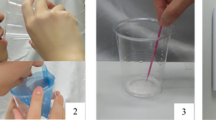Summary
This series of three articles describes the principle possibility of analyzing human mastication with a standard food model and jaw tracking recording. The results of six participants (3 male, 3 female, age ranges from 17 to 52 years) are described in detail. The electronically generated data of hinge axis movement allows further analysis and provides a deeper insight to the dynamics of human mastication. Within this article and within the limitation of the small number of participants in this case series the time curves and translation rotation curves are explained in details. This series will be continued by part 3 (movement of cusps during mastication).
Zusammenfassung
Im Teil 1 dieser Artikelserie wurde beschrieben, welche grundsätzlichen Möglichkeiten bei der Analyse des menschlichen Kauens mit Hilfe der Condylographie bestehen. Dabei wurde anhand von exemplarischen Fallstudien gezeigt, dass deutliche individuelle Unterschiede bei der Analyse des menschlichen Kauzyklus mit Hilfe eines Standardnahrungsmodells und dem Einsatz einer Bewegungsaufzeichnung des Unterkiefers erkannt und beschrieben werden können. Auf der Basis der beschriebenen Fallserie scheint es ableitbar, dass Alter, Zahnstatus, Qualität der Okklusion und skelettale Relation einen modifizierenden Einfluss auf die Kaumuster des Individuums haben. Die Fähigkeit, Standardnahrung innerhalb einer bestimmten Zeit zu zerkauen, ist sehr unterschiedlich, und zeigt eine hohe Varianz. Die elektronische Aufzeichnung der Bewegung der Scharnierachse mit Hilfe der Condylographie bietet weiterführende Analysemöglichkeiten mit vertieftem Einblick in die Dynamik der Unterkieferbewegungen. Anhand der vorgestellten Daten von sechs Teilnehmern an diesen Fallstudien (3 männlich, 3 weiblich, Alter 17 bis 52 Jahre) werden die erweiterten Möglichkeiten zur Analyse des menschlichen Kauens mit Hilfe eines Standardnahrungsmodells und der Kiefergelenkbahnaufzeichnung dargestellt. In diesem Teil der Artikelserie wird das Zeit-Weg Diagramm und das Translation-Rotation-Diagramm detailiert beschrieben und der Nutzen bei der Auswertung der Kaubewegungen dargestellt. Auch bei diesen speziellen Funktionen der Condylographie sind die Unterschiede in den Kaufunktionen darstellbar, die sich bei den verschiedenen Teilnehmern an dieser Fallserie ergeben haben. Die Serie wird mit Teil 3 (Analyse der Höckerbewegungen während des menschlichen Kauens) fortgesetzt.
Similar content being viewed by others
References
Colombo V, Palla S, Gallo LM (2008) Temporomandibular joint loading patterns related to joint morphology: a theoretical study. Cells Tissues Organs 187: 295–306
Dellow PG, Lund JP (1971) Evidence for central timing of rhythmical mastication. J Physiol 215: 1–13
Felicio CM, Melchior Mde O, Silva MA, Celeghini RM (2007) Masticatory performance in adults related to temporo-mandibular disorder and dental occlusion. Pró-Fono Revista de Atualização Cientifica 19: 151–158
Foster KD, Woda A, Peyron MA (2006) Effect of texture of plastic and elastic model foods on the parameters of mastication. J Neurophys 95: 3469–3479
Gibbs CH, Mahan PE, Lundeen HC, Brehnan K, Walsh EK, Sinkewiz SL, Ginsberg SB (1981) Occlusal forces during chewing – Influences of biting strength and food consistency. J Prosth Dent 46 (5): 561–567
Lazzari V, Charles C, Tafforeau P, Vianey-Liaud M, Aguilar JP, Jaeger JJ, Michaux J, Viriot L (2008) Mosaic Convergence of Rodent Dentitions. PlosOne 3 (10): e3607
Okayasu I, Yamada Y, Kohno S, Yoshida N (2003) New animal model for studying mastication in oral motor disorders. J Dent Res 82 (4): 318–321
Orthlieb JD, Slavicek R (1985) Geometrische Interpretation der Spee Kurve. Stomatologie 82: 1–18
Patchell FC, Shine R (1986) Feeding Mechanisms in pygopodid Lizards: How can Lialis swallow such large prey? J Herpetology 20 (1): 59–64
Prinz JF, Lucas PW (1997) An optimization model for mastication and swallowing in mammals. ProcRSoc Lond 264: 1715–1721
Slavicek G, Soykher M, Gruber H, Siegl P, Oxtoby M (2009a) A novel standard food model to analyze the individual parameters of human mastication. IJSOM 2: 4
Slavicek G, Soykher M, Gruber H, Siegl P, Oxtoby M (2009b) Fallstudien zur Analyse des Kauens Teil 1: Die Standardanalyse. Stomatologie 106: 7
Wall CE, Smith KK (2001) Ingestion in Mammals. Enc Life Sci 1: 1–6
Woda A, Foster K, Mishellany A, Peyron MA (2006) Adaptation of healthy masctication to factors pertaining to the individual or to the food. Physiology & Behavior 89: 28–35
Author information
Authors and Affiliations
Corresponding author
Rights and permissions
About this article
Cite this article
Slavicek, G., Soykher, M., Gruber, H. et al. Fallstudien zur Analyse des Kauens Teil 2: Spezielle Analysemöglichkeiten. Stomatologie 106, 137–148 (2009). https://doi.org/10.1007/s00715-009-0103-z
Published:
Issue Date:
DOI: https://doi.org/10.1007/s00715-009-0103-z
Keywords
- Human mastication
- Standard food model
- Mandibular movement
- EMG
- Condylography
- Biomechanics
- Temporo-mandibular joint
- Chewing
- Swallowing
- Chewing muscle activity
- Craniomandibular system
- Nutrition
- Tooth loss




